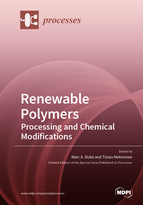Renewable Polymers: Processing and Chemical Modifications
A special issue of Processes (ISSN 2227-9717). This special issue belongs to the section "Materials Processes".
Deadline for manuscript submissions: closed (31 March 2019) | Viewed by 58227
Special Issue Editors
Interests: polymer reaction engineering applied to kinetics; polymer characterization, modeling, and process monitoring for multicomponent bulk, solution, and emulsion polymer systems; polymers from renewable materials; and sustainable polymer production methods for pressure-sensitive adhesives
Interests: design and modification of polymers; renewable resourced polymers; nanostructured polymers; multiphase polymers as applied to polymer blends, composites and nanocomposites; functional application of polymers
Special Issue Information
Dear Colleagues,
The utilization of renewable resources for polymer production is receiving substantial interest. While only about 6% of the petroleum produced globally is used for the manufacturing of polymers, there are alarming environmental and safety concerns associated with both the feedstock used to produce polymers and their end-of-life disposal. One possible solution to mitigate these negative environmental consequences is to develop more sustainable polymers via the use of renewable raw materials. Feedstock such as proteins, cellulose, starch, lignin, chitosan, gums, vegetable oils, terpenes, polyphenols can be used for the manufacture of a variety of sustainable materials and products, including elastomers, plastics, hydrogels, flexible electronics, sensors, engineering polymers, and composites. Various novel processing technologies and chemical modification strategies are also being implemented to make these feedstocks more suitable for polymeric materials.
We propose a Special Issue on “Renewable polymers: Processing and Chemical Modifications” to publish high-quality work focusing on novel and recent advances in renewable polymers and nanoparticles for material applications, including biomedical, sensors, membranes, coatings, antimicrobial packaging, etc. The topics of interest include, but are not limited to:
- Renewable feedstock for polymer applications
- Processes for the fabrication of renewable polymer-based nanomaterials
- Design and modification of renewable polymers
- Applications of renewable polymers
Prof. Dr. Marc A. Dubé
Prof. Dr. Tizazu Mekonnen
Guest Editors
Manuscript Submission Information
Manuscripts should be submitted online at www.mdpi.com by registering and logging in to this website. Once you are registered, click here to go to the submission form. Manuscripts can be submitted until the deadline. All submissions that pass pre-check are peer-reviewed. Accepted papers will be published continuously in the journal (as soon as accepted) and will be listed together on the special issue website. Research articles, review articles as well as short communications are invited. For planned papers, a title and short abstract (about 100 words) can be sent to the Editorial Office for announcement on this website.
Submitted manuscripts should not have been published previously, nor be under consideration for publication elsewhere (except conference proceedings papers). All manuscripts are thoroughly refereed through a single-blind peer-review process. A guide for authors and other relevant information for submission of manuscripts is available on the Instructions for Authors page. Processes is an international peer-reviewed open access monthly journal published by MDPI.
Please visit the Instructions for Authors page before submitting a manuscript. The Article Processing Charge (APC) for publication in this open access journal is 2400 CHF (Swiss Francs). Submitted papers should be well formatted and use good English. Authors may use MDPI's English editing service prior to publication or during author revisions.
Keywords
- Renewable polymers
- Processing of polymers
- Polymerization
- Polymer modifications
- Functional applications of polymers







